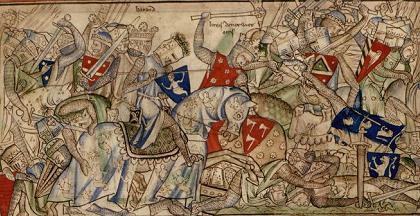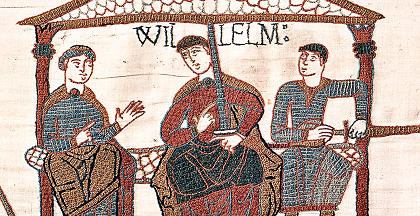Key facts about the Battle of Hastings
- The Battle of Hastings took place on 14 October 1066
- It was fought between the Normans and the English
- William of Normandy ('the Conqueror') defeated Harold Godwinsson
- As a result of the battle, William became king of England
People you need to know
- Edgar Ætheling - son of Edward the Exile and great-nephew of Edward the Confessor.
- Edward the Confessor - king of England between 1042 and 1066 who died childless. Read our article on him here.
- Harold Godwinsson - powerful politician who was named ruler of England in 1066.
- Harald Hardrada - king of Norway from 1046 until 1066.
- William of Normandy - illegitimate son of Robert I, duke of Normandy; and duke of Normandy from 1035.
The Battle of Hastings is considered to be one of the most important battles of England's history. Often taken as the definitive point when England stopped being Anglo-Saxon and instead became Norman - with all the associated changes in government and culture - it was in fact long-lasting, hard-fought and visceral. And it was by no means a foregone conclusion.
Background to the battle
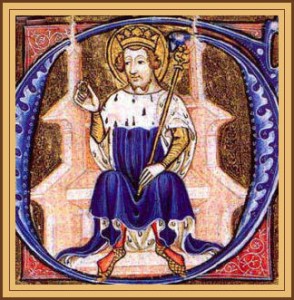
Edward the Confessor died childless on 5 January 1066, and Harold Godwinsson, an exceptionally wealthy and powerful noble who had no royal blood, declared he had been named as heir on Edward's deathbed. The Witangemot, the leading men in the country, agreed and Harold was hastily consecrated as king just one day after. and prevent people from questioning the convenience of Edward dying without a named heir and behind closed doors. In so doing, Harold angered William of Normandy, who had a distant claim to the throne,
and prevent people from questioning the convenience of Edward dying without a named heir and behind closed doors. In so doing, Harold angered William of Normandy, who had a distant claim to the throne, and who had perhaps already been named as Edward's heir.
and who had perhaps already been named as Edward's heir.
Furthermore, Godwinsson and William had a history: when Harold narrowly avoided shipwreck off the coast of Normandy in 1064 and was taken hostage by the count of Ponthieu, William came to his aid. They spent some time fighting together against the duke of Brittany, after which William knighted Harold. But more importantly, Harold swore an oath on holy relics that he would support William's claim to the throne and 'that he would strive to the utmost with his counsel and with his wealth to ensure that the English monarchy should be pledged to [William] after Edward's death'.
They spent some time fighting together against the duke of Brittany, after which William knighted Harold. But more importantly, Harold swore an oath on holy relics that he would support William's claim to the throne and 'that he would strive to the utmost with his counsel and with his wealth to ensure that the English monarchy should be pledged to [William] after Edward's death'. Both Norman and later English sources agree this happened, but the English ones state it was done under duress, as the only way Harold could return home safely. The Norman ones, however, say the oath was willingly given. According to the Normans, therefore, William had a sacred duty to invade England and rid it of an oath-breaker.
Both Norman and later English sources agree this happened, but the English ones state it was done under duress, as the only way Harold could return home safely. The Norman ones, however, say the oath was willingly given. According to the Normans, therefore, William had a sacred duty to invade England and rid it of an oath-breaker.
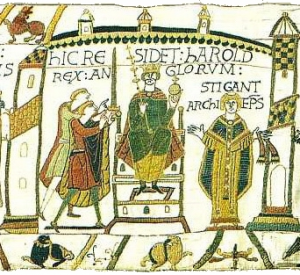
Harold was expecting trouble in 1066, would protect everyone, the peasants would pay for this protection by working the land, and the clergy would pray for everyone. In the secular world, the monarch was at the top of the pyramid, with each layer of nobility… obligations - lists 14 names and the number of ships they were required to provide for the invasion fleet, with some being obliged to provide over 100 each. Even without this, a terrible omen appeared in the sky in April 1066, forewarning of imminent disaster: Halley's Comet. and kept his army on the south coast of England for much of the summer, awaiting an invasion force that couldn't sail due to unfavourable winds. This would have been a logistical nightmare for both armies. Marc Morris suggests that around 25 tons of grain and 30,000 gallons of water would be needed every day to keep the Norman army of 7,000 men and 2,000 horse alive on basic rations. To keep morale high, meat, fish, wine and ale would also have been required. In addition, the waste all these people and animals produced needed to have been dealt with to avoid disease.
would protect everyone, the peasants would pay for this protection by working the land, and the clergy would pray for everyone. In the secular world, the monarch was at the top of the pyramid, with each layer of nobility… obligations - lists 14 names and the number of ships they were required to provide for the invasion fleet, with some being obliged to provide over 100 each. Even without this, a terrible omen appeared in the sky in April 1066, forewarning of imminent disaster: Halley's Comet. and kept his army on the south coast of England for much of the summer, awaiting an invasion force that couldn't sail due to unfavourable winds. This would have been a logistical nightmare for both armies. Marc Morris suggests that around 25 tons of grain and 30,000 gallons of water would be needed every day to keep the Norman army of 7,000 men and 2,000 horse alive on basic rations. To keep morale high, meat, fish, wine and ale would also have been required. In addition, the waste all these people and animals produced needed to have been dealt with to avoid disease. The Norman army coped well with the delay: they stayed at the coast waiting patiently and, according to William of Poitiers, behaving remarkably well.
The Norman army coped well with the delay: they stayed at the coast waiting patiently and, according to William of Poitiers, behaving remarkably well. But on 8 September 1066, Harold dismissed his army, no longer able to feed them, hoping the approaching autumn would delay William until the next year.
But on 8 September 1066, Harold dismissed his army, no longer able to feed them, hoping the approaching autumn would delay William until the next year.
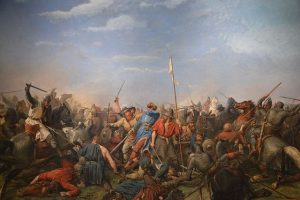
Unknown to Harold, there was an imminent threat from another quarter. Harald Hardrada, king of Norway (and with an exceedingly tenuous claim to the English throne), had decided to invade the north of England to claim the crown for himself. The sudden appearance of an invading army in the north of the country forced Harold to march his just-disbanded army to York, where he defeated Hardrada at the Battle of Stamford Bridge on 25 September.
The sudden appearance of an invading army in the north of the country forced Harold to march his just-disbanded army to York, where he defeated Hardrada at the Battle of Stamford Bridge on 25 September.
The Norman landings
After a month of waiting, the winds changed and William was able to set sail on either 27 or 28 September. He landed his fleet of perhaps 700-800 vessels of all kinds on the south coast at Pevensey just one or two days later.
on the south coast at Pevensey just one or two days later. It is said that on disembarking William tripped and got a mouthful of sand. Turning it to his advantage, just as Caesar had done over 1100 years previously, he said he already had the soil of England in his grasp.
It is said that on disembarking William tripped and got a mouthful of sand. Turning it to his advantage, just as Caesar had done over 1100 years previously, he said he already had the soil of England in his grasp.
Interestingly, William probably had no idea at this point who he would be fighting: news would have reached him of the Viking attack in the north, but not of its victor. This news, we are told, reached him at the start of October, and wasn't taken as a good sign. Edward the Confessor's Norman adviser and friend, Robert the Steward, delivered the message and warned William to 'stay behind his fortifications'.
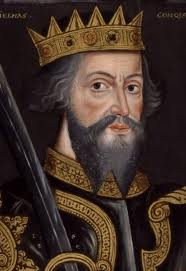
News of William's invasion reached Harold probably on 1 October - at roughly the same time that William received word of Harold's victory - while Harold was resting his army at York. He therefore had to return to the south coast, via London probably to arrange new levies to fill his army, arriving on 13 October. In the meantime the two sides communicated through messages. William offered Harold the earldom of Wessex if he were to step down as king; 'Harold, rather less generously, promised to let William return to Normandy unmolested if he made reparations for the damage he caused.'
Unsurprisingly, neither side backed down and the stage was set for a second battle, at least for Harold. Having travelled the length of the country twice in a month (and fought a battle in between), Harold was forced to meet William, and with an ill-prepared army. Perhaps Harold should have waited longer in London for reinforcements: his family and the medieval chroniclers, as well as most historians, all thought so. But every day he delayed gave the Normans more time to pillage the countryside around Hastings, and to kill and maim the local peasantry. It is also possible that Harold attempted to take the enemy by surprise by attacking sooner than expected, rather like he did at Stamford Bridge.
The Battle of Hastings
Whether Harold intended to surprise William or not, on 14 October 1066 it was Harold who was surprised and taken unprepared by the approach of the Norman army. and inspired by the Pope's endorsement of the venture. William, forewarned of Harold's approach from London, had kept his army up all of the preceding night in readiness, and set out at sunrise to find him. The two forces met at Senlac, about six miles inland from Hastings,
and inspired by the Pope's endorsement of the venture. William, forewarned of Harold's approach from London, had kept his army up all of the preceding night in readiness, and set out at sunrise to find him. The two forces met at Senlac, about six miles inland from Hastings, at roughly nine o-clock in the morning. A sudden rush to arms followed, with William reportedly in such a hurry that he put his mail shirt on back-to-front.
at roughly nine o-clock in the morning. A sudden rush to arms followed, with William reportedly in such a hurry that he put his mail shirt on back-to-front.
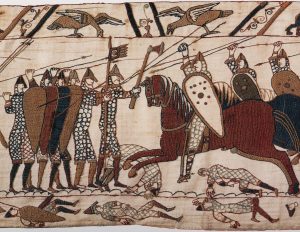
We don't know who had the larger army, as both sides insisted theirs was the smallest. . Harold had the better ground (he was uphill), but William the better tactics, considerably more archers, and cavalry.
. Harold had the better ground (he was uphill), but William the better tactics, considerably more archers, and cavalry. It would seem that Harold, in his haste to reach the invading army, hadn't recruited enough men: the Bayeux Tapestry, for example, shows just one English archer, compared with dozens on the Norman side.
It would seem that Harold, in his haste to reach the invading army, hadn't recruited enough men: the Bayeux Tapestry, for example, shows just one English archer, compared with dozens on the Norman side.
Despite these discrepancies, the battle was hard-fought and lasted all day. While the English held the higher ground and didn't break rank they stood a chance of winning, even against cavalry, who couldn't charge up such difficult ground. The shield wall served them well, as contemporary chronicler and chaplain to William, William of Poitiers, wrote: 'It was an unheard-of kind of combat, with one side launching ceaseless attacks and manoeuvres, the other standing firmly as though rooted to the ground.' There was one Norman though, who according to the Carmen de Hastingae Proelio ('Song of the Battle of Hastings') eventually convinced an English warrior to leave the shield wall. The Norman, Taillefer, rode between the armies jeering at the English and juggling his sword, encouraging any man who dared to try his luck in single combat. Eventually, one Englishman became so irritated that he went forward to cut the Norman down, but failed. Instead, it was the Anglo-Saxon who was run through with the knight's lance, before being decapitated and having his head displayed as a trophy.
There was one Norman though, who according to the Carmen de Hastingae Proelio ('Song of the Battle of Hastings') eventually convinced an English warrior to leave the shield wall. The Norman, Taillefer, rode between the armies jeering at the English and juggling his sword, encouraging any man who dared to try his luck in single combat. Eventually, one Englishman became so irritated that he went forward to cut the Norman down, but failed. Instead, it was the Anglo-Saxon who was run through with the knight's lance, before being decapitated and having his head displayed as a trophy.
After a hard morning and afternoon of fighting, the Normans turned tail and seemed to flee the battlefield. There are differing accounts of why this happened: maybe a rumour spread that William of Normandy had been killed, or perhaps it was a ruse that turned into a real panic. Whatever the cause, all sources state that William had to take off his helmet and assure his troops that he was alive before they calmed. But importantly, it encouraged the English to break rank, leaving the safety of their shield wall and hilltop position to pursue the Normans down the hill. With the Anglo-Saxons now on equal ground, Norman superiority became clear. By the time the Normans were finished with them, there weren't enough English left to form an effective shield wall. Still they might have fought on, but for the news that Harold had fallen.
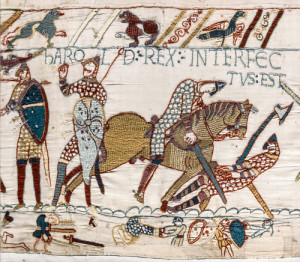
Popular myth says that Harold was shot in the eye with an arrow, but this is based on a misreading of the Bayeux Tapestry and the reports of later writers. Contemporary chroniclers tend not to mention an arrow, but the Carmen states he was hacked to death by William and his knights. There could also be a pleasanter - although much less likely - end to Harold's tale: the rumour goes that he was rescued after the battle and somehow survived his wounds to live out his days as a monk, either in Essex or at a local abbey.
Once the English king was killed, there seemed little point for the remains of the exhausted and defeated army to continue the fight. Instead, those who could turned and fled. Most did not get very far: they were chased by the victors on horseback and were cut down. According to William of Poitiers, 'Far and wide the earth was covered with the flower of the English nobility , sitting immediately below the monarch in terms of blood and title; or the quality of being noble (virtuous, honourable, etc.) in character. and youth, drenched in gore.'
, sitting immediately below the monarch in terms of blood and title; or the quality of being noble (virtuous, honourable, etc.) in character. and youth, drenched in gore.' But not only the English suffered: as the Normans pursued the English into the night, many were killed when they rushed unawares into an old rampart.
But not only the English suffered: as the Normans pursued the English into the night, many were killed when they rushed unawares into an old rampart.
Aftermath
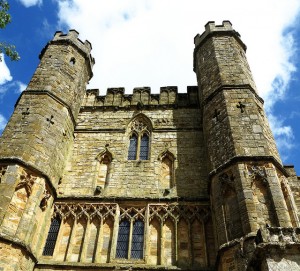
After the battle, William waited in Hastings for the Saxon nobles to pay him homage. Although William of Poitiers reported that 'the forces of Normandy had subjugated all the cities of the English in a single day', the Normans had in fact just taken a tiny part of Sussex. It was therefore a far safer strategy to wait in Norman-controlled territory for the Anglo-Saxons to come to him than it was to march on London.
the Normans had in fact just taken a tiny part of Sussex. It was therefore a far safer strategy to wait in Norman-controlled territory for the Anglo-Saxons to come to him than it was to march on London.
Many of the English, however, had other ideas. No-one came to Hastings to surrender and instead the 13-year-old great-nephew of Edward the Confessor, Edgar Ætheling, was declared king. After two weeks of waiting, William left Hastings and went further along the coast, first to Romney,
After two weeks of waiting, William left Hastings and went further along the coast, first to Romney, and then on to Dover. Here they burnt the town, although perhaps accidentally, and, due to drinking water and eating freshly-killed meat, came down with dysentery. Those well enough continued with William to London, with many towns along the way (including Winchester, the home of the Treasury) surrendering to them. London was less easy to subdue. After a skirmish perhaps on the bridge between the Londoners and the Normans, they both retreated and William set about harrying the surrounding countryside, a standard technique used to bully the enemy into surrender. William's persistence, and his crossing of the Thames at Wallingford to harry the land around London, gradually wore down Edgar's supporters. By December, London's resistance had collapsed and Edgar, with his remaining nobles, went to Berkhamstead to pay homage to William.
and then on to Dover. Here they burnt the town, although perhaps accidentally, and, due to drinking water and eating freshly-killed meat, came down with dysentery. Those well enough continued with William to London, with many towns along the way (including Winchester, the home of the Treasury) surrendering to them. London was less easy to subdue. After a skirmish perhaps on the bridge between the Londoners and the Normans, they both retreated and William set about harrying the surrounding countryside, a standard technique used to bully the enemy into surrender. William's persistence, and his crossing of the Thames at Wallingford to harry the land around London, gradually wore down Edgar's supporters. By December, London's resistance had collapsed and Edgar, with his remaining nobles, went to Berkhamstead to pay homage to William.
William was crowned in Westminster Abbey on Christmas Day 1066, but the Conquest had only just begun. It would be another five years before William could say he was master of all England. Pockets of resistance continued across the country: Chester didn’t fall to the Normans until 1070 and Hereward the Wake resisted from the Isle of Ely, in the middle of the Lincolnshire Fens, until 1071.
but the Conquest had only just begun. It would be another five years before William could say he was master of all England. Pockets of resistance continued across the country: Chester didn’t fall to the Normans until 1070 and Hereward the Wake resisted from the Isle of Ely, in the middle of the Lincolnshire Fens, until 1071.
Things to think about
- Did William of Normandy have a legitimate claim to the English throne?
- What had Harold Godwinsson been doing to get shipwrecked in Normandy in the first place?
- How did Harold Godwinsson die?
- Could the Anglo-Saxons under Harold Godwinsson have won the Battle of Hastings?
- How easy was it for William to subdue the Anglo-Saxons after the Battle of Hastings?
Things to do
- Visit Battle Abbey, the battlefield and visitor centre, owned by English Heritage. If possible, time it right and see one of their living history or re-enactment events. You can find out more information about visiting here.
- What would be a more accurate version of the Bayeux Tapestry? Draw your own version of it!
Further reading
There tends to be a split in the thinking of historians, between pro-Normans and pro-Anglo-Saxons. Two books that reflect this split are Marc Morris's The Norman Conquest - The Battle of Hastings and the Fall of Anglo-Saxon England and Ian Walker's Harold: The Last Anglo-Saxon King.
Two books that reflect this split are Marc Morris's The Norman Conquest - The Battle of Hastings and the Fall of Anglo-Saxon England and Ian Walker's Harold: The Last Anglo-Saxon King.

